Finch-like
? species
| Finch-like honeycreepers of Hawaii | ||||
|---|---|---|---|---|
| Taxa | Presence | Notes | Images | |
Honeycreeper:
|  | |||
This is a List of adaptive radiated Hawaiian honeycreepers by form; these are the Hawaiian honeycreepers, especially the extinct forms, lost through late-European colonization. (These are adaptive radiative equivalents.)
? species
| Finch-like honeycreepers of Hawaii | ||||
|---|---|---|---|---|
| Taxa | Presence | Notes | Images | |
Honeycreeper:
|  | |||
? species
| Hummingbird-like honeycreepers of Hawaii | ||||
|---|---|---|---|---|
| Taxa | Presence | Notes | Images | |
Honeycreeper:
|  | |||
? species
| Parrot-like honeycreepers of Hawaii | ||||
|---|---|---|---|---|
| Taxa | Presence | Notes | Images | |
Honeycreeper: |  | |||
1 species-?
| "Longhorn beetle harvester" honeycreepers of Hawaii | ||||
|---|---|---|---|---|
| Taxa | Presence | Notes | Images | |
Honeycreeper: |  | |||
? species
| Warbler-like honeycreepers of Hawaii | ||||
|---|---|---|---|---|
| Taxa | Presence | Notes | Images | |
Honeycreeper:
| Extirpated from Lanai |  | ||
? species
| Woodpecker-like honeycreepers of Hawaii | ||||
|---|---|---|---|---|
| Taxa | Presence | Notes | Images | |
Honeycreeper:
| 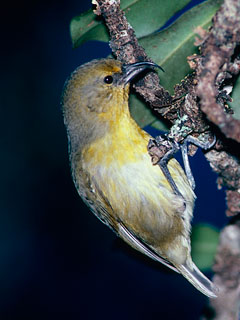 | |||
? species
| Finch-like honeycreepers of Hawaii—(surviving species) | ||||
|---|---|---|---|---|
| Taxa | Presence | Notes | Images | |
honeycreeper:
|  | |||
1 species
True hummingbird-like species are all extinct.
| (FINCH-like)–(secondary)– hummingbird-like–(Hawaiian lobelioid-specialist)–honeycreepers of Hawaii—(surviving species) | ||||
|---|---|---|---|---|
| Taxa | Presence | Notes | Images | |
Honeycreeper:
|  | |||
4 species
| Parrot-like honeycreepers of Hawaii—(surviving species) | ||||
|---|---|---|---|---|
| Taxa | Presence | Notes | Images | |
Genus: |    | |||
Genus: | ||||
? species
(the only warbler-like?, (the other amakihi 's radiated-?))
| Warbler-like honeycreepers of Hawaii—(surviving species) | ||||
|---|---|---|---|---|
| Taxa | Presence | Notes | Images | |
Honeycreeper:
| Extirpated from Lanai |  | ||
1 species
| Woodpecker-like honeycreepers of Hawaii—(surviving species) | ||||
|---|---|---|---|---|
| Taxa | Presence | Notes | Images | |
honeycreeper:
|  | |||

In evolutionary biology, adaptive radiation is a process in which organisms diversify rapidly from an ancestral species into a multitude of new forms, particularly when a change in the environment makes new resources available, alters biotic interactions or opens new environmental niches. Starting with a single ancestor, this process results in the speciation and phenotypic adaptation of an array of species exhibiting different morphological and physiological traits. The prototypical example of adaptive radiation is finch speciation on the Galapagos, but examples are known from around the world.

The true finches are small to medium-sized passerine birds in the family Fringillidae. Finches have stout conical bills adapted for eating seeds and nuts and often have colourful plumage. They occupy a great range of habitats where they are usually resident and do not migrate. They have a worldwide distribution except for Australia and the polar regions. The family Fringillidae contains more than two hundred species divided into fifty genera. It includes species known as siskins, canaries, redpolls, serins, grosbeaks and euphonias.

Biogeography is the study of the distribution of species and ecosystems in geographic space and through geological time. Organisms and biological communities often vary in a regular fashion along geographic gradients of latitude, elevation, isolation and habitat area. Phytogeography is the branch of biogeography that studies the distribution of plants. Zoogeography is the branch that studies distribution of animals. Mycogeography is the branch that studies distribution of fungi, such as mushrooms.
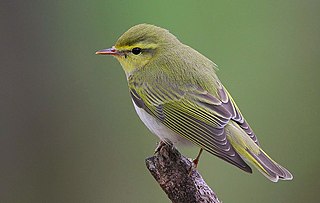
Various Passeriformes are commonly referred to as warblers. They are not necessarily closely related to one another, but share some characteristics, such as being fairly small, vocal, and insectivorous.

The rosefinches are a genus, Carpodacus, of passerine birds in the finch family Fringillidae. Most are called "rosefinches" and as the word implies, have various shades of red in their plumage. The common rosefinch is frequently called the "rosefinch". The genus name is from the Ancient Greek terms karpos, "fruit" and dakno, "to bite".

The ʻiʻiwi or scarlet honeycreeper is a species of Hawaiian honeycreeper. The ʻiʻiwi is a highly recognizable symbol of Hawaiʻi. The ʻiʻiwi is the third most common native land bird in the Hawaiian Islands.

The poʻo-uli, or black-faced honeycreeper, is an extinct species of passerine bird that was endemic to the island of Maui in Hawaiʻi. It is considered to be a member of the Hawaiian honeycreepers, and is the only member of its genus Melamprosops. It had a black head, brown upper parts and pale gray underparts. This bird inhabited only the wetter, easternmost side of Maui, where it had rapidly decreased in numbers. With extinction threatening, efforts were made to capture birds to enable them to breed in captivity. These efforts were unsuccessful; in 2004, only two known birds remained, and since then, no further birds have been sighted. A 2018 study recommended declaring the species extinct, citing bird population decline patterns and the lack of any confirmed sightings since 2004, and in 2019, the species was declared extinct.
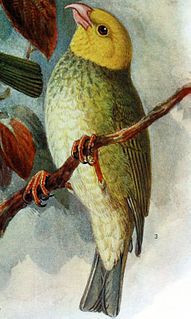
The ʻōʻū is a species of Hawaiian honeycreeper, that is endemic to the Hawaiian islands. It has a dark green back and olive green underparts; males have a yellow head while females have a green head. Its unusual beak seems to be adapted to feeding on the fruits of Freycinetia arborea. It has a strong flight which it uses to fly considerable distances in search of this Hawaiian endemic vine, but will eat other fruits, buds, flowers and insects.
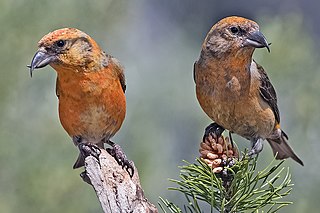
The cardueline finches are a subfamily, Carduelinae, one of three subfamilies of the finch family Fringillidae, the others being the Fringillinae and the Euphoniinae. The Hawaiian honeycreepers are now included in this subfamily. Except for the Hawaiian honeycreepers which underwent adaptive radiation in Hawaii and have evolved a broad range of diets, cardueline finches are specialised seed eaters, and unlike most passerine birds, they feed their young mostly on seeds, which are regurgitated. Besides this, they differ from the other finches in some minor details of their skull. They are adept at opening seeds and clinging to stems, unlike other granivorous birds, such as sparrows and buntings, which feed mostly on fallen seeds. Some members of this subfamily are further specialised to feed on a particular type of seed, such as cones in the case of crossbills. Carduelines forage in flocks throughout the year, rather than keeping territories, and males defend their females rather than a territory or nest.

The Lānaʻi hookbill is an extinct species of Hawaiian honeycreeper. It was endemic to the island of Lānaʻi in Hawaiʻi, and was last seen in the southwestern part of the island. George C. Munro collected the only known specimen of this species in 1913, which is housed in the Bernice P. Bishop Museum in Honolulu, and saw the species only twice more, once in 1916 and for a final time in 1918. No other sightings have been reported. They inhabited montane dry forests dominated by ʻakoko and ōpuhe. The Lānaʻi hookbill was monotypic within the genus Dysmorodrepanis and had no known subspecies. Its closest relative is believed to be the ʻōʻū, and some early authors suggested that the Lānaʻi hookbill was merely a deformed ʻōʻū. The Lānaʻi hookbill was a plump, medium-sized bird with greenish olive upperparts and pale whitish yellow underparts. It also had a yellow or white superciliary line and a white chin and throat. The wings also had a distinctive and conspicuous white wing patch. The hookbill's distinguishing characteristic was its heavy, parrotlike bill, which had the mandibles hooking sharply towards each other, leaving a gap between them when the beak was closed.

The ʻakiapōlāʻau, pronounced ah-kee-ah-POH-LAH-OW, is a species of Hawaiian honeycreeper that is endemic to the island of Hawaii. Its natural habitats are dry and montane moist forests, and the only bird species on the island to occupy the woodpecker niche. The bird is 5.5 inches (14 cm) in length, and has an unusually curved beak-(a specialist species). The ʻakiapolaʻau is a pudgy bird which has a whitish bottom and tail, black legs, yellow chest, orangish head, black face mask and bill and gray black wings. The male's song is either a loud, short pit-er-ieu or a rapid warba-warba. Its various calls include an upslurred whistle, a short cheedle-ee warble, and a short sweet. Due to the recent disappearance of the Kauai nukupuʻu in the 1900s and the Maui nukupuʻu in the 1990s, leading to fears that they may be extinct, the ʻakiapōlāʻau may be the last of its genus. It is the only member of the subgenus Heterorhynchus, which has a woodpecker-like feeding habitat and exclusively preys on insects, in contrast to the nukupu'us, which were both insect-eaters and also hummingbird-like nectarivores.
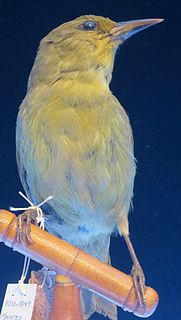
The greater ʻamakihi was a species of Hawaiian honeycreeper in the subfamily Carduelinae of the family Fringillidae.
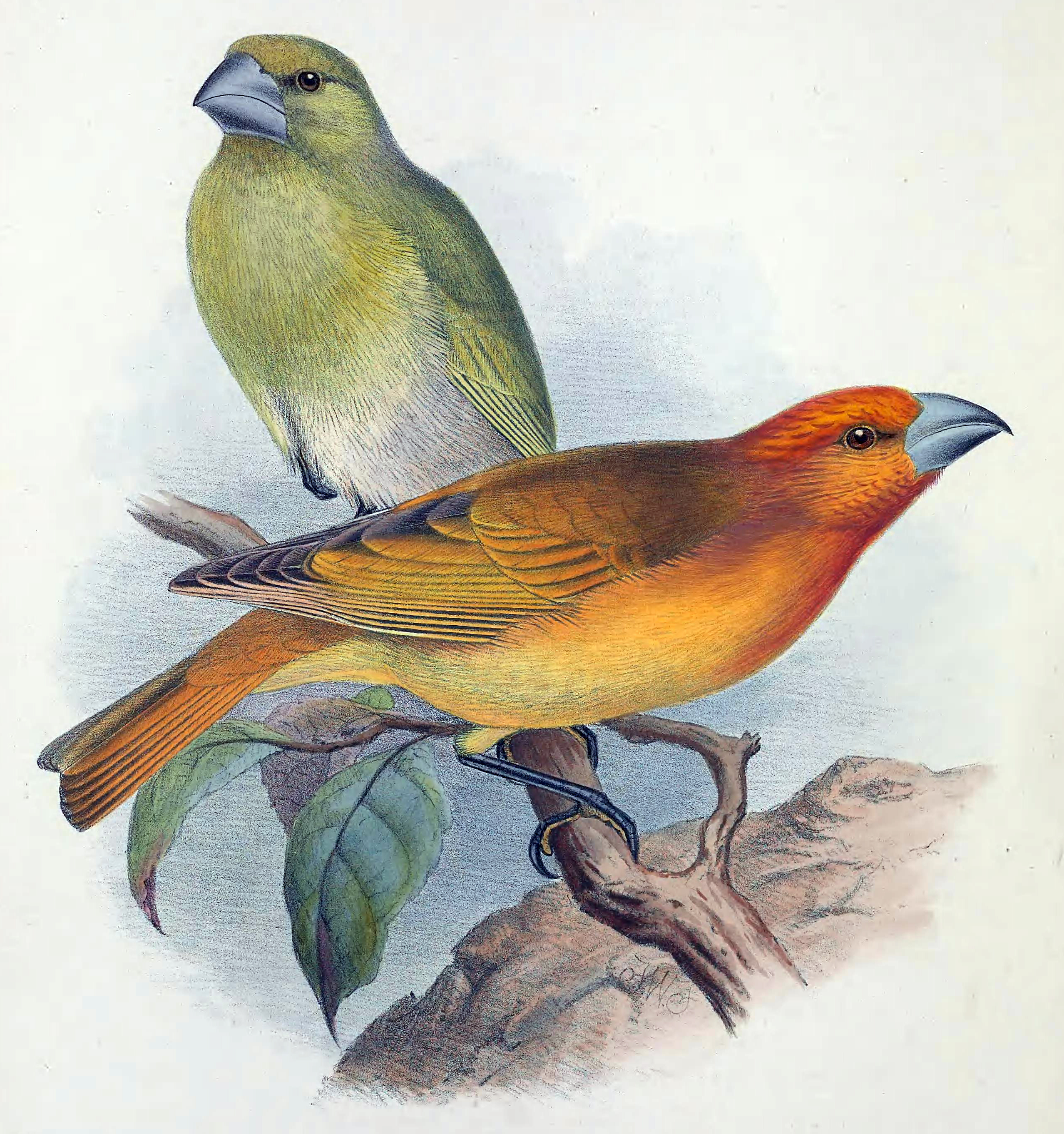
Rhodacanthis is an extinct genus of Hawaiian honeycreepers commonly known as koa finches. All four species were endemic to the Hawaiian Islands. Members of this genus were granivores, with bills adapted to the seeds and pods of legumes. The two species that became extinct in the 1890s, R. flaviceps and R. palmeri, inhabited upper elevation mesic forests dominated by koa (Acacia koa) on the island of Hawaiʻi. Both were large birds; R. flaviceps measured 19 cm (7.5 in), while R. palmeri was 23 cm (9.1 in) in length. The combination of a giant bill with brightly colored plumage gave the males a very striking appearance. Koa seeds were the preferred food for the two species, but caterpillars were taken if necessary. The two prehistoric species, R. forfex and R. litotes, were denizens of more lowland tropical dry forests and shrublands on Kauaʻi, Maui, and Oʻahu. It is speculated that koaiʻa was an important food source for both species, as their range did not overlap with that of koa. Kanaloa pods and ʻaʻaliʻi berries were probably also eaten in addition to the occasional caterpillar.
The scissor-billed koa finch, or scissor finch is an extinct species of Hawaiian honeycreeper. Of the four species in the genus Rhodacanthis, the scissor-billed koa finch and the primitive koa finch became extinct before the arrival of the first Europeans to Hawaii in 1778. It was endemic to the islands of Maui and Kauaʻi in the Hawaiian Islands.
The primitive koa finch is a species of Hawaiian honeycreeper. It was endemic to Hawaiʻi. Of the four species in the genus Rhodacanthis, it and the scissor-billed koa finch became extinct before the arrival of the first Europeans to Hawaiʻi in 1778. It is known as the ancestor of all koa finches.
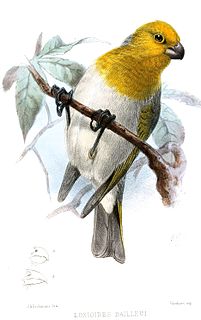
Psittirostrini is a formerly-recognized tribe of Hawaiian honeycreepers. It was used for the finch-like honeycreepers that once inhabited all of the Hawaiian Islands. These birds are granivorous and have songs like those of non-Hawaiian cardueline finches. The only definitely extant species are the Laysan finch, the Nihoa finch, the Maui parrotbill, and the palila. Extinct species include the koa finches, the ʻōʻū, and the Lanaʻi hookbill.
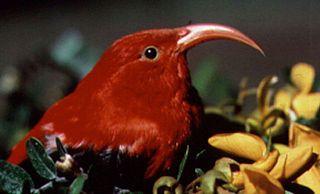
Hawaiian honeycreepers are a group of small, passerine birds endemic to Hawaiʻi. They are closely related to the rosefinches in the genus Carpodacus, but many species have evolved features unlike those present in any other finch. Their great morphological diversity is the result of adaptive radiation in an insular environment. Many have been driven to extinction since the first humans arrived in Hawaii, with extinctions increasing over the last 2 centuries following European discovery of the islands, with habitat destruction and especially invasive species being the main causes.
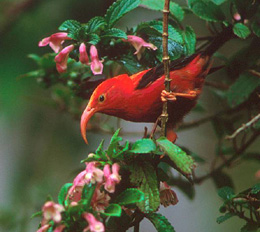
Drepanidini is a tribe of cardueline finches containing the Hawaiian honeycreepers. It was formerly considered one of three Hawaiian honeycreeper tribes, and restricted to the genera Ciridops, Drepanis, Himatione, Melamprosops, and Palmeria, most of which are nectarivores with brightly-colored or boldly-patterned plumage and songs containing nasal squeaks and whistles. However, as these three tribes were each para- or polyphyletic, and as Hawaiian honeycreepers are no longer treated as their own subfamily or family, Drepanidini is now typically used for all Hawaiian honeycreepers.
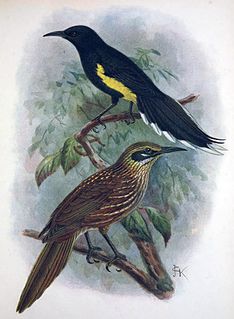
Mohoidae is a family of Hawaiian species of recently extinct, nectarivorous songbirds in the genera Moho (ʻōʻō) and Chaetoptila (kioea). These now extinct birds form their own family, representing the only complete extinction of an entire avian family in modern times, when the disputed family Turnagridae is regarded as invalid. The last surviving species in the family, the Kauaʻi ʻōʻō, went extinct in 1987.